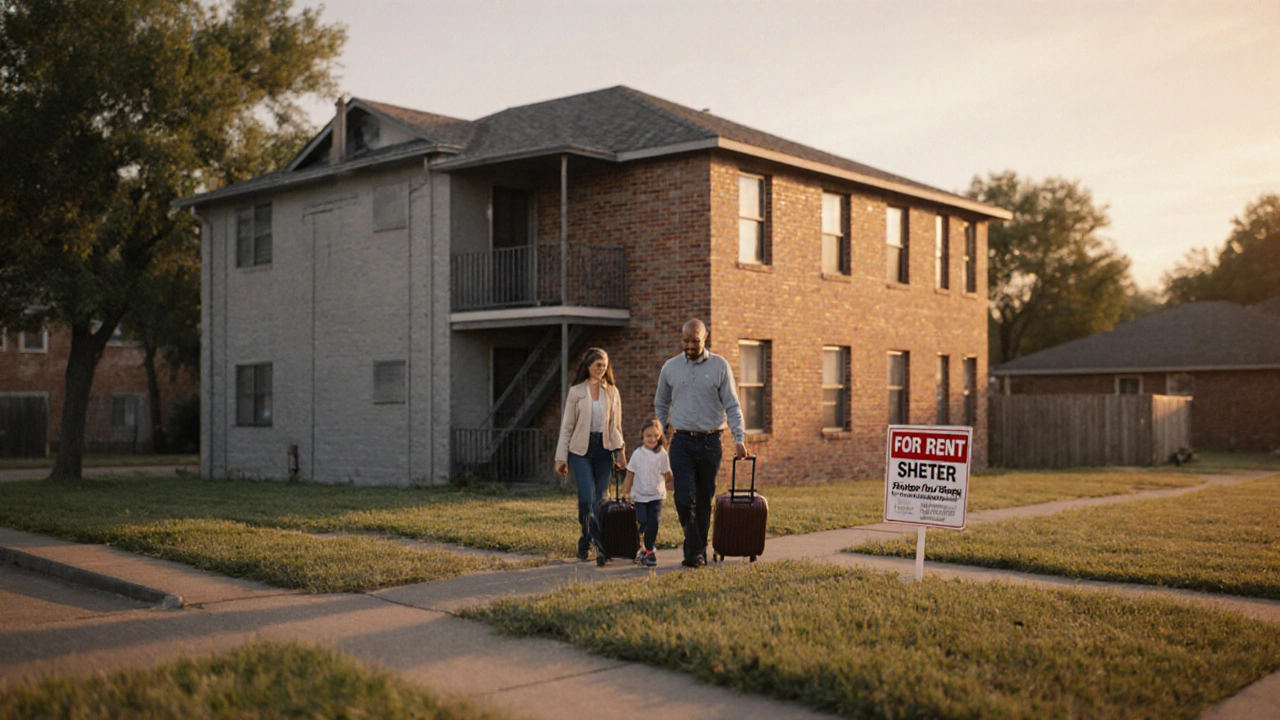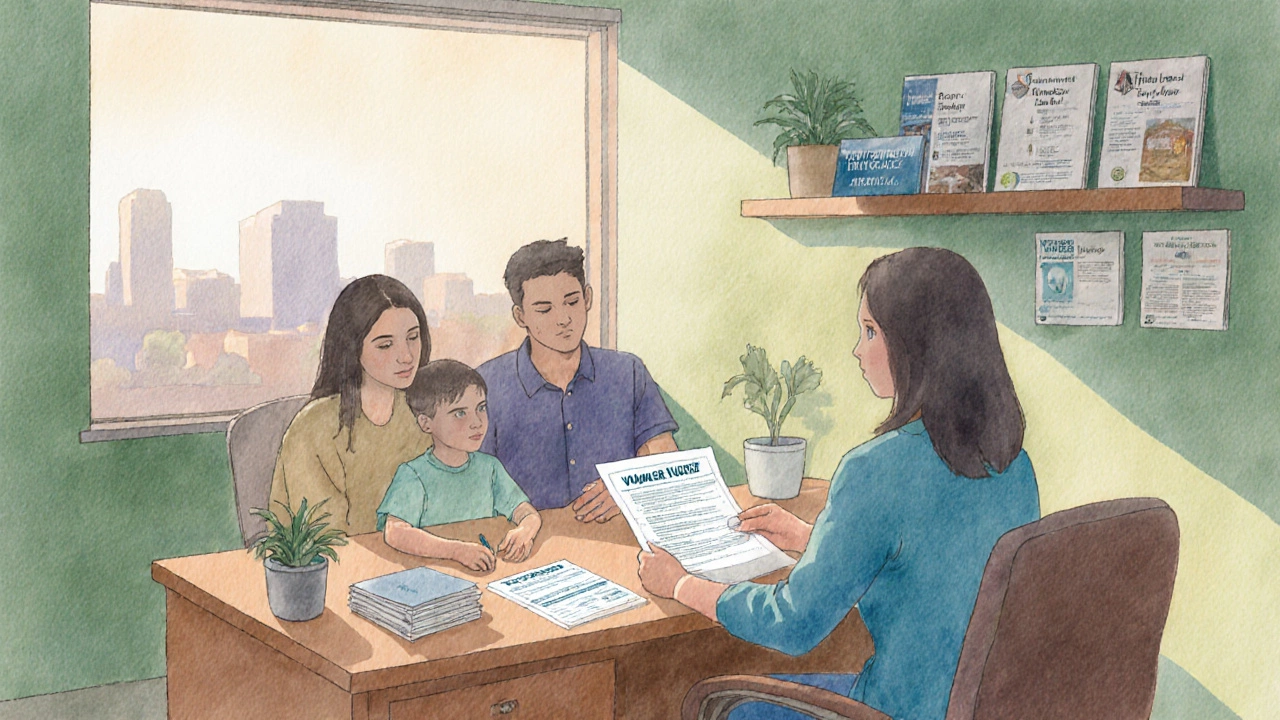Rapid Re-Housing Program in Arkansas: How It Works and Who Can Benefit
 Oct, 5 2025
Oct, 5 2025
When we talk about Rapid Re-Housing program is a short‑term housing assistance model that helps people move quickly from emergency shelter into stable, permanent housing, Arkansas has built a system that blends federal funding with local support to cut the time families spend on the streets. Rapid Re-Housing Arkansas isn’t a one‑size‑fits‑all grant - it’s a coordinated set of services, vouchers, and case management designed to get people home fast and keep them there.
What is Rapid Re-Housing?
Rapid Re‑Housing (RRH) originated from a national push to reduce chronic homelessness by offering a brief, intensive intervention. Instead of long‑term subsidized housing, RRH provides a short lease (usually up to 12 months), a modest cash assistance amount for rent and utilities, and a case manager who helps the household set up utilities, find employment, and connect to medical care.
The model is backed by the U.S. Department of Housing and Urban Development (HUD), which funnels Community Development Block Grant (CDBG) funds through local Continuums of Care (CoCs). Arkansas’ CoC covers the entire state, so every county can tap into the same funding stream.
How the Arkansas Program is Structured
- Funding source: Federal CDBG‑ARC money blended with state allocations managed by the Arkansas Department of Human Services (ADHS).
- Eligibility gate: Local Continuum of Care agencies review applications and determine who qualifies for a voucher.
- Voucher type: A housing voucher that covers up to 80% of the market rent, capped at the local Fair Market Rent (FMR) for a one‑bedroom unit.
- Cash assistance: Up to $400 per month for utilities, furniture, or security deposits, paid directly to the household.
- Case management: A case manager works with the family for 3-6 months, linking them to job training, child‑care, and health services.
This structure keeps administrative costs low while giving families the flexibility to choose a rental unit that fits their needs.
Who Can Apply?
The program targets households that are currently homeless or at imminent risk of homelessness. Typical applicants include:
- Families leaving an emergency shelter after a crisis such as eviction, domestic violence, or job loss.
- Individuals exiting prison or foster care who need a stable address to rebuild their lives.
- Veterans who have been discharged from temporary housing but lack long‑term support.
Eligibility is verified through a combined assessment of income (must be at or below 50% of the Area Median Income), homelessness status, and willingness to engage with a case manager. Households with severe mental health or substance‑use issues are usually referred to more intensive services, but they can still qualify if a treatment plan is in place.

Key Benefits and Services
Rapid Re‑Housing delivers three core outcomes:
- Speed: Most families move into permanent housing within 30‑45 days of approval.
- Stability: By covering the bulk of rent and utilities, the program reduces the risk of re‑entry into shelters.
- Self‑sufficiency: Case managers help participants set up budgeting tools, apply for employment, and enroll in health insurance.
In the 2023 fiscal year, Arkansas reported a 71% housing retention rate after the voucher period ended - meaning three out of four families stayed housed without additional assistance.
Step‑by‑Step: Getting Started
- Contact your local Continuum of Care office. They will run a quick intake interview and collect documentation (ID, proof of income, eviction notice, etc.).
- Complete the eligibility assessment. A case worker checks your household size, income level, and homelessness status.
- Receive a voucher. Once approved, you’ll get a voucher code to present to landlords.
- Find housing. Work with the case manager to locate a unit that meets the rent ceiling and passes a basic inspection.
- Move in. The voucher covers rent; utilities assistance is disbursed directly to you.
- Engage in case management. Attend monthly check‑ins, set up a budgeting plan, and connect to job‑training programs.
- Transition out. After 3-6 months, the case manager helps you transition to self‑pay or a longer‑term subsidy if needed.
If any step stalls, the case manager can troubleshoot - for example, finding a landlord willing to accept the voucher or arranging emergency utility credit.
Common Pitfalls to Avoid
- Missing paperwork. Incomplete documentation can delay approval by weeks. Keep copies of pay stubs, birth certificates, and eviction notices ready.
- Choosing a unit above the rent cap. Landlords often quote higher rents; verify the advertised price against the Fair Market Rent tables published by HUD.
- Skipping case manager meetings. Attendance is tied to continued assistance. Not showing up can result in loss of utility funds.
- Not budgeting for future rent. The voucher ends, so families need a realistic plan to cover the full rent after exit.
Being proactive on these fronts smooths the journey and improves the chances of staying housed long‑term.

Resources and Next Steps
Here are a few go‑to tools for anyone interested in Rapid Re‑Housing in Arkansas
- Arkansas Department of Human Services Rapid Re‑Housing page - official eligibility checklist and contact list.
- HUD Continuum of Care directory - find your local CoC office.
- Benefits.gov guide to Rapid Re‑Housing - national overview and federal funding details.
- Local non‑profits such as Union Gospel Mission and Volunteers of America Arkansas often act as referral partners.
Start by calling the nearest Continuum office. A quick conversation can clarify whether you meet the income threshold and what paperwork you’ll need.
Eligibility Checklist
| Criterion | Requirement | Proof Needed |
|---|---|---|
| Homeless status | Currently in shelter or at imminent risk of eviction | Shelter intake form or eviction notice |
| Income level | ≤50% of Area Median Income | Recent pay stubs, tax return, or SSI award letter |
| Household size | 1-8 members | Birth certificates or school enrollment letters |
| Willingness to engage | Agree to regular case‑manager meetings | Signed intake agreement |
| Legal residency | U.S. citizen, permanent resident, or qualified non‑citizen | Green card, visa, or refugee documentation |
Frequently Asked Questions
What is the difference between Rapid Re‑Housing and Section 8?
Rapid Re‑Housing offers a short‑term voucher (usually up to 12 months) plus cash assistance for utilities, aiming to move people quickly out of shelters. Section 8 provides a long‑term subsidy that can last years or decades, with a higher income eligibility threshold.
How long does it take to get a voucher after applying?
In most Arkansas counties, the process takes 2-4 weeks once all documents are submitted. Delays usually stem from missing paperwork or a backlog at the local Continuum office.
Can I use the voucher for a mobile home?
Yes, if the mobile home meets HUD’s safety standards and the rent falls within the local Fair Market Rent ceiling. The unit must also pass an inspection by the case manager.
What happens after the voucher period ends?
The household is expected to transition to self‑pay or apply for another long‑term subsidy. The case manager helps create a budget and may refer the family to local affordable‑housing programs.
Is there a limit to how many times I can use Rapid Re‑Housing?
Generally, a household can receive assistance only once every five years, unless a significant change in circumstances (like a domestic‑violence incident) is documented.
Do I need to have a job to qualify?
Employment is not a prerequisite, but having a source of income improves the likelihood of a successful transition. Case managers often link participants to job‑training programs immediately after placement.
Can veterans get additional benefits on top of Rapid Re‑Housing?
Yes. Veterans can combine the voucher with VA homeless assistance programs, which may cover additional security deposits or provide counseling services.
